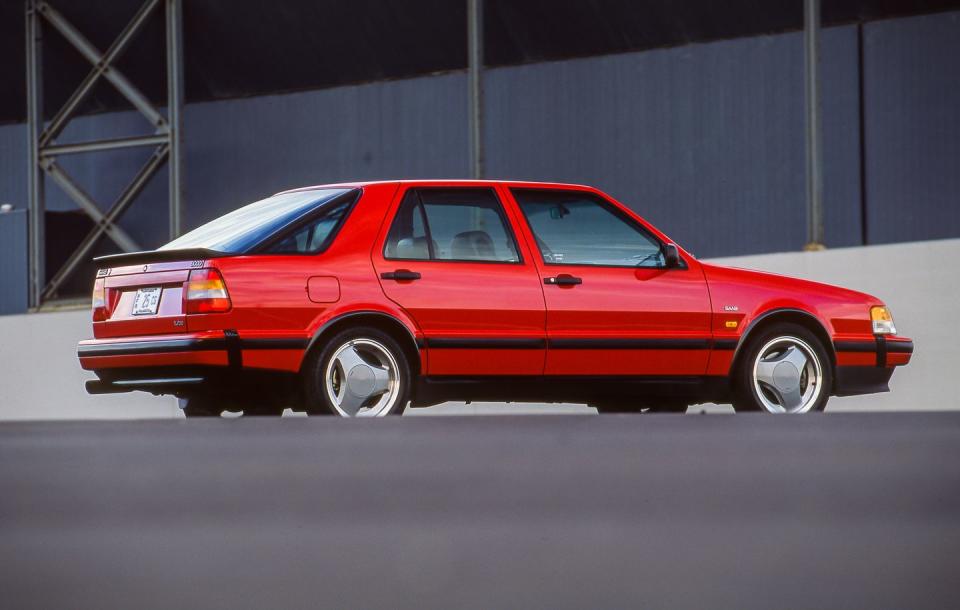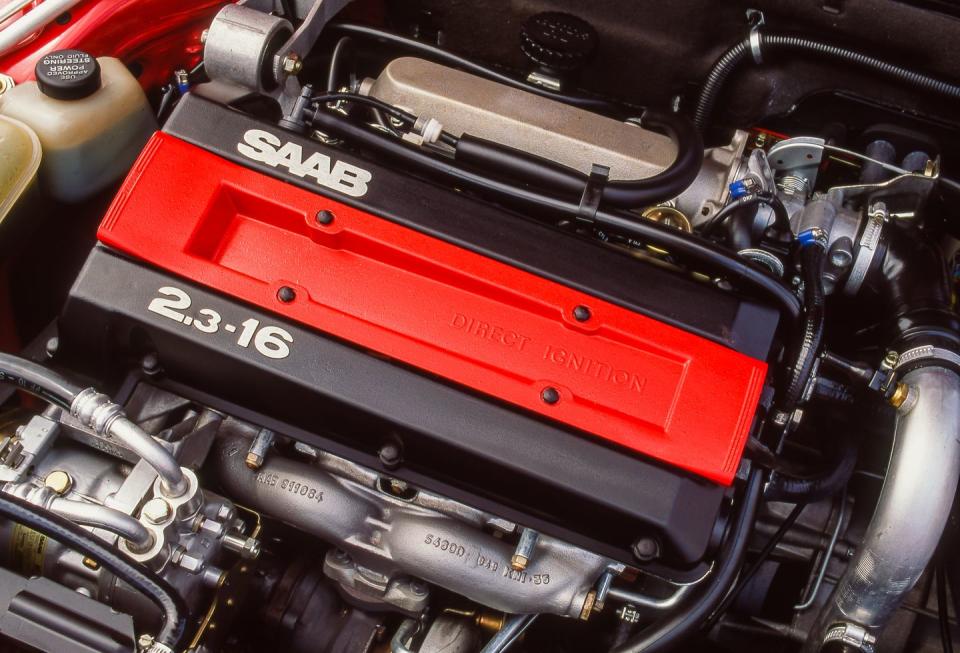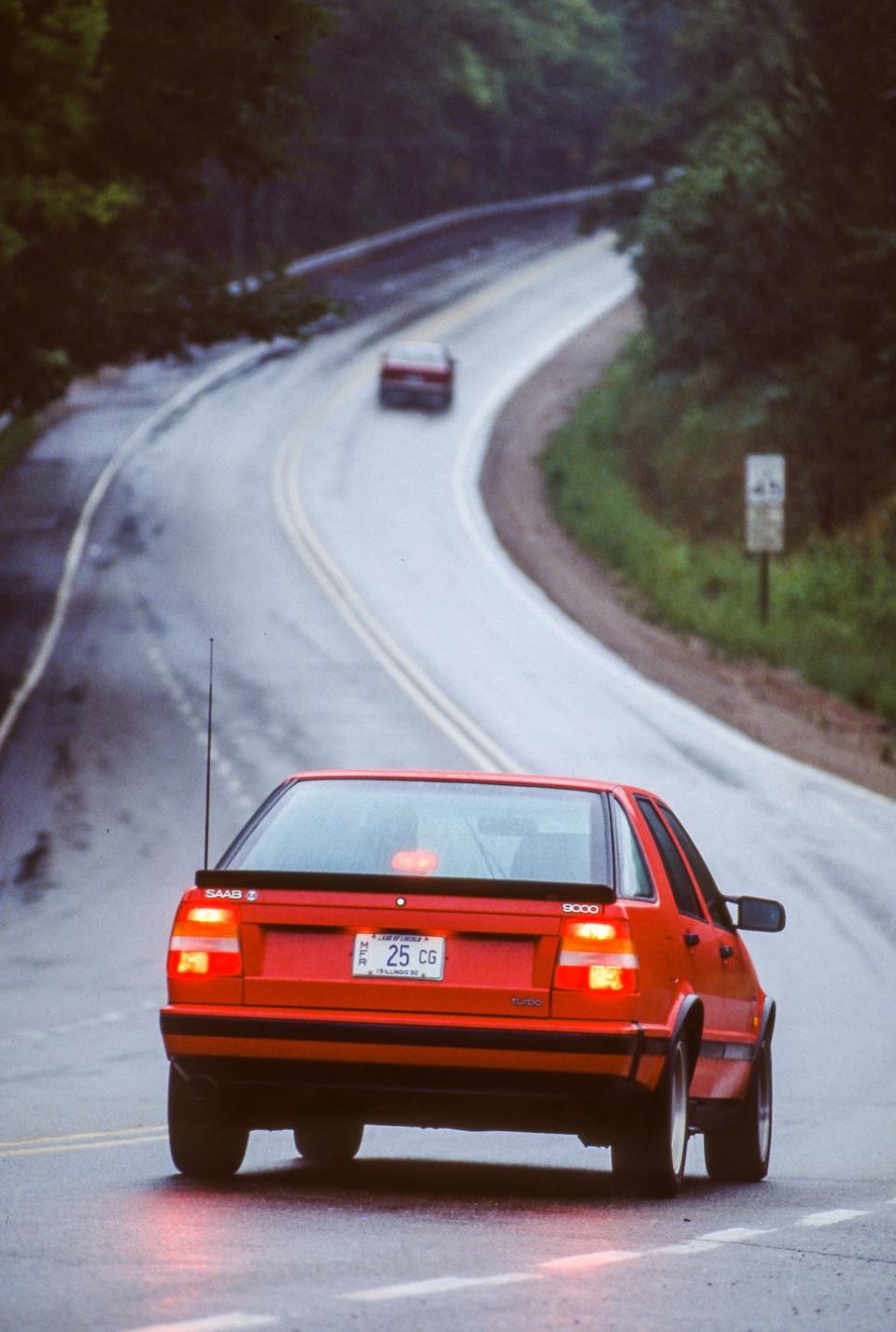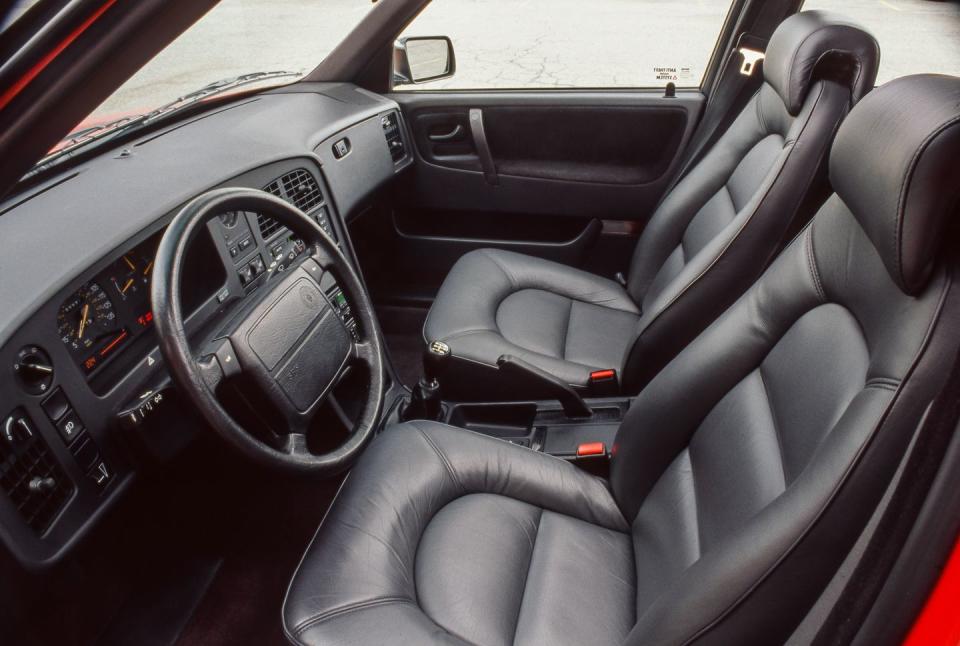Tested: 1991 Saab 9000 Turbo Challenges the Sports Sedan Norm

From the February 1991 issue of Car and Driver.
The Saab 9000 Turbo is an old friend—long-legged, accommodating, intelligent, well built, and sexy. The sort of athletic child you'd expect from, say, the union of Erik Carlsson and Ingrid Bergman. How good is the 9000 Turbo? Since its United States introduction in 1985, it has landed on C/D's 10Best list four times.
Last year, however, the 9000 Turbo was not-so-gently nudged off its perch. The reason? As the sexy Swede's price rocketed into the lofty $32,000 region, there was no correspondingly lofty increase in performance.
Now the 9000 Turbo has a dear shot at regaining its misplaced glory. Why? The answer is simple: a 21-percent increase in power.
Telling you that this 3170-pound five-passenger sedan is fast is like telling you that David Lynch is a degree or two off-center. Dump the clutch at only 2700 rpm and the Saab's front tires do a reasonable impersonation of Chernobyl. Back off a couple of hundred rpm and this car will drag you to 60 mph in 6.4 seconds—and that includes two upshifts, as second gear carries the engine into its 6000-rev limiter at 59 mph.

That zero-to-60 time is quicker than any we've witnessed for a mass-produced five-passenger sedan, save the $60,000 BMW M5. Quicker than a Taurus SHO. Quicker than an Infiniti Q45. In fact, 6.4 seconds is the time it takes a Toyota MR2 Turbo to tackle 60 mph.
The 9000 Turbo's newly pumped-up pees are the upshot of more displacement (2.3 liters rather than last year's 2.0 liters) and an increase in turbo boost (14.5 psi, as opposed to 10.9 pounds in the last Turbo we tested). The iron block, as it happens, is entirely new, greatly strengthened in the crankshaft area and now equipped with counterrotating balance shafts, which deal spectacularly with the not-so-subtle pulses of 90mm-wide pistons pumping up and down through a 90mm stroke.
For 1991, this larger turbocharged and intercooled four-cylinder engine produces 200 horsepower at 5000 rpm and 244 pound-feel of torque at an amazingly low 2000 rpm. That's more torque than is produced by the V-8 in a Mercedes 420SEL.
In day-to-day driving, what zings you most is not so much the Saab's zero-to-60-mph prowess—the power of Scruttock's ale—but rather its off-the-line capability and its 50-to-70-mph passing potential.
Accelerating from rest is no longer characterized by that maddening one- or two-second bog as the turbo spools up—a trait that began to drive us berserk in last year's Turbo. What you want when the traffic light snaps green is power that manifests shortly after you've let out the clutch in first gear—which, in this car, works out to about 1750 rpm. At those revs, the old engine could produce 162 pound-feet of torque; the new one has 221 pound-feet on tap. It's the difference between having the national anthem sung by Roseanne Barr and Kate Smith. There's no longer any need to slip the clutch to keep the revs and boost on the boil. In fact, there's enough power here that, in the rain, you can spin the front tires through first, second, and third gears. (Okay, that's an odd thing to want to do, but demonstrate it to your neighbor who owns a Mercedes 190E and you'll remember the look on his face for the next six months.)

With no fancy footwork, you can tap full boost as low as 2000 rpm (rather than 3000 rpm in the old Turbo). From there until the power peak of 5000 rpm, this engine pulls like the heartiest husky in the Iditarod. Torque steer is evident in first gear only—a side-to-side skittishness that is not alarming but does encourage you to keep both hands on the wheel. On a two-lane road, when you're lugging along in fourth gear at only 45 mph—stuck behind a diesel Chevette—there is still so much passing power that a downshift to third isn't necessary. And a fifth-gear 50-to-70-mph sprint requires only 6.8 seconds—your exposure in the passing lane is briefer than a Toyota MR2 Turbo's.
Having wisely identified the hatchback 9000 Turbo as its dedicated performance sedan, Saab now adds as standard equipment a "sport chassis," available only on this model. The package includes spiffy 6.5-by-16-inch three-spoke alloy wheels, 50-series Z-rated Pirelli P700 rubber, a lower ride height (0.8 inch lower at the nose, 0.4 inch lower at the tail), more aggressive struts and springs, and a marginally fatter front anti-roll bar.
With those tires and springs, the ride—as you might well predict—is harsher this year, yet the car's ultimate 0.77-g grasp on the earth's crust is no more tenacious than that of the 9000CD we tested last June. Mostly what you get out of the deal is less lateral roll and a steering system that responds more crisply to minor steering inputs. It's a fair trade-off as long as you don't live in Michigan, New York, or Pennsylvania, where the roads are something out of a Road Warrior remake.

For 1991, the Turbo looks more like a road warrior, too. The window frames, the door handles, and the rub-strip moldings are now all flat black. The bumpers are finally body-colored (but only on red, white, and black Turbos). And the rocker panels have been restyled to give the car the radically pinched waist of a Choi Kwang-Do instructor.
Having worked so diligently to improve the Turbo this year, we wish Saab had also massaged the manual shift linkage. The fiddly reverse-lockout collar is an anachronism, and the throws still feel unnecessarily rubbery. Part of what we're feeling is the Playtex-pliable bushings that Saab has always used to isolate both the engine and the transmission. In practice, that isolation is nearly total; what you hear and feel of this engine is mostly a distant throb of cam chains. But when you suddenly lift from full-throttle stabs in first through third gears, you get two inches of annoying driveline lash.
Cockpits in luxury cars must pass our informal tactile test. Does the driver's hand ever fall on a surface that feels cheesy or insubstantial? The 9000, with its acres of standard Bridge of Weir leather—including its new-for-1991 leather-wrapped steering wheel, shift knob, and shift boot—borders on tactile and olfactory overload. Even the inner linings of the A-pillars are covered in a plush, velvety fabric; it's like rubbing the inside of a rabbit' ear.

This year, the 9000 Turbo's cockpit includes as standard equipment almost every option in the automotive universe: power windows and locks, eight-way power-adjustable front seats with memory, a steel (rather than glass) sunroof, heated mirrors and seats, a driver-side air bag, a burglar alarm, an eight-speaker Clarion AM/FM/cassette player with seven-band graphic equalizer, cruise control, the aforementioned leather, and...well, you get the drift. In fact, the only options are a $765 automatic transmission and $535 metallic paint.

 Yahoo Autos
Yahoo Autos 